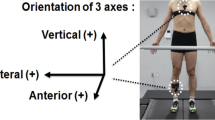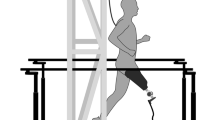Abstract
The present study evaluated gait asymmetry in elite runners by quantifying the differences between ground contact times (GCTs) of the right and left foot and its continuous changes over the course of a 5-km time trial on a 400-m synthetic track. By means of the inertial sensor Axiamote, the GCT of every step was assessed. The results revealed an overall gait asymmetry of 2.6%, but no changes in gait asymmetry over the course of the 5-km time trial. On the bend, the GCTs of the left foot were significantly (p < .001) longer than the GCTs of the right foot, whereas no such differences were reported on the straight section. However, gait asymmetry remained the same for both the straight and bend Sects. (2.7 vs. 2.8%). Overall, no gender differences regarding gait asymmetry occurred. In conclusion, a low and consistent gait asymmetry between GCTs of both feet in male and female runners was observed.
Access this chapter
Tax calculation will be finalised at checkout
Purchases are for personal use only
Similar content being viewed by others
References
Girard, O., Millet, G.P., Slawinski, J., Racinais, S., Micallef, J.P.: Changes in running mechanics and spring-mass behaviour during a 5-km time trial. Int. J. Sports Med. 34, 832–840 (2013)
Murphy, A.J., Lockie, R.G., Coutts, A.J.: Kinematic determinants of early acceleration in field sport athletes. J. Sports Sci. Med. 2, 144–150 (2003)
Nummela, A.T., Keranen, T., Mikkelsson, L.O.: Factors related to top running speed and economy. Int. J. Sports Med. 28, 655–661 (2007)
Croisier, J.L., Forthomme, B., Namurois, M.H., Vanderthommen, M., Crielaard, J.M.: Hamstring muscle strain recurrence and strength performance disorders. Am. J. Sports Med. 30, 199–203 (2002)
Cavanagh, P.R., Williams, K.R.: The effect of stride length variation on oxygen uptake during distance running. Med. Sci. Sports Exerc. 14, 30–35 (1982)
Gurney, B.: Leglength discrepancy. Gait Post 15, 195–206 (2002)
Nummela, A.T., Heath, K.A., Paavolainen, L.M., Lambert, M.I., St. Clair Gibson, A., Rusko, H.K., Noakes, T.D.: Fatigue during a 5-km running time trial. Int. J. Sports Med. 29, 738–745 (2008)
Churchill, S.M., Salo, A.I., Trewartha, G.: The effect of the bend on technique and performance during maximal effort sprinting. Sports Biomech. 14, 106–121 (2015)
Alt, T., Heinrich, K., Funken, J., Potthast, W.: Lower extremity kinematics of athletics curve sprinting. J. Sports Sci. 33, 552–560 (2015)
Weyand, P.G., Sternlight, D.B., Bellizzi, M.J., Wright, S.: Faster top running speeds are achieved with greater ground forces not more rapid leg movements. J. Appl. Physiol. 89, 1991–1999 (2000)
Paavolainen, L., Nummela, A., Rusko, H., Hakkinen, K.: Explosive-strength training improves 5-km running time by improving running economy and muscle power. J. Appl. Physiol. 86, 1527–1533 (1999)
Morin, J.B., Samozino, P., Zameziati, K., Belli, A.: A simple method for measuring stiffness during running. J. Appl. Biomech. 21, 167–180 (2005)
Brughelli, M., Cronin, J., Mendiguchia, J., Kinsella, D., Nosaka, K.: Contralateral leg deficits in kinetic and kinematic variables during running in Australian rules football players with previous hamstring injuries. J. Strength Cond. Res. 24, 2539–2544 (2010)
Kong, P.W., de Heer, H.: Anthropometric, gait and strength characteristics of Kenyan distance runners. J. Sports Sci. Med. 7, 499–504 (2008)
Belli, A., Lacour, J.R., Komi, P.V., Candau, R., Denis, C.: Mechanical step variability during treadmill running. Eur. J. Appl. Physiol. Occup. Physiol. 70, 510–517 (1995)
Nigg, B.M., de Boer, R.W., Fisher, V.: A kinematic comparison of overground and treadmill running. Med. Sci. Sports Exerc. 27, 98–105 (1995)
Meinel, K.: Competition area. In: International Association of Athletics Federations, IAAF Track and Field Facilities Manual, pp. 31–54. Multiprint, Monaco (2008)
Ammann, R., Taube, W., Wyss, T.: Accuracy of PARTwear inertial sensor and Optojump optical measurement system for measuring ground contact time during running. J. Strength Cond. Res. 30(7), 2057–2063 (2015)
Robinson, R.O., Herzog, W., Nigg, B.M.: Use of force platform variables to quantify the effects of chiropractic manipulation on gait symmetry. J. Manipulative Physiol. Ther. 10, 172–176 (1987)
Zifchock, R.A., Davis, I., Hamill, J.: Kinetic asymmetry in female runners with and without retrospective tibial stress fractures. J. Biomech. 39, 2792–2797 (2006)
Rumpf, M.C., Cronin, J.B., Mohamad, I.N., Mohamad, S., Oliver, J.L., Hughes, M.G.: Kinetic asymmetries during running in male youth. Phys. Ther. Sport 15, 53–57 (2014)
Williams, K.R., Snow, R., Agruss, C.: Changes in distance running kinematics with fatigue. Int. J. Sport Biomech. 7, 138–162 (1991)
Acknowledgement
The authors thank the Swiss Orienteering National Team and the head coach Patrik Thoma for their effort, and the Swiss Athletics middle- and long-distance coach Louis Heyer for his expertise.
Author information
Authors and Affiliations
Corresponding author
Editor information
Editors and Affiliations
Rights and permissions
Copyright information
© 2016 Springer International Publishing AG
About this paper
Cite this paper
Ammann, R., Taube, W., Wyss, T. (2016). Gait Asymmetry During a 5-Km Time Trial in Elite Runners: A Descriptive Study. In: Cabri, J., Pezarat Correia, P. (eds) Sports Science Research and Technology Support. icSPORTS 2015. Communications in Computer and Information Science, vol 632. Springer, Cham. https://doi.org/10.1007/978-3-319-52770-3_2
Download citation
DOI: https://doi.org/10.1007/978-3-319-52770-3_2
Published:
Publisher Name: Springer, Cham
Print ISBN: 978-3-319-52769-7
Online ISBN: 978-3-319-52770-3
eBook Packages: Computer ScienceComputer Science (R0)




